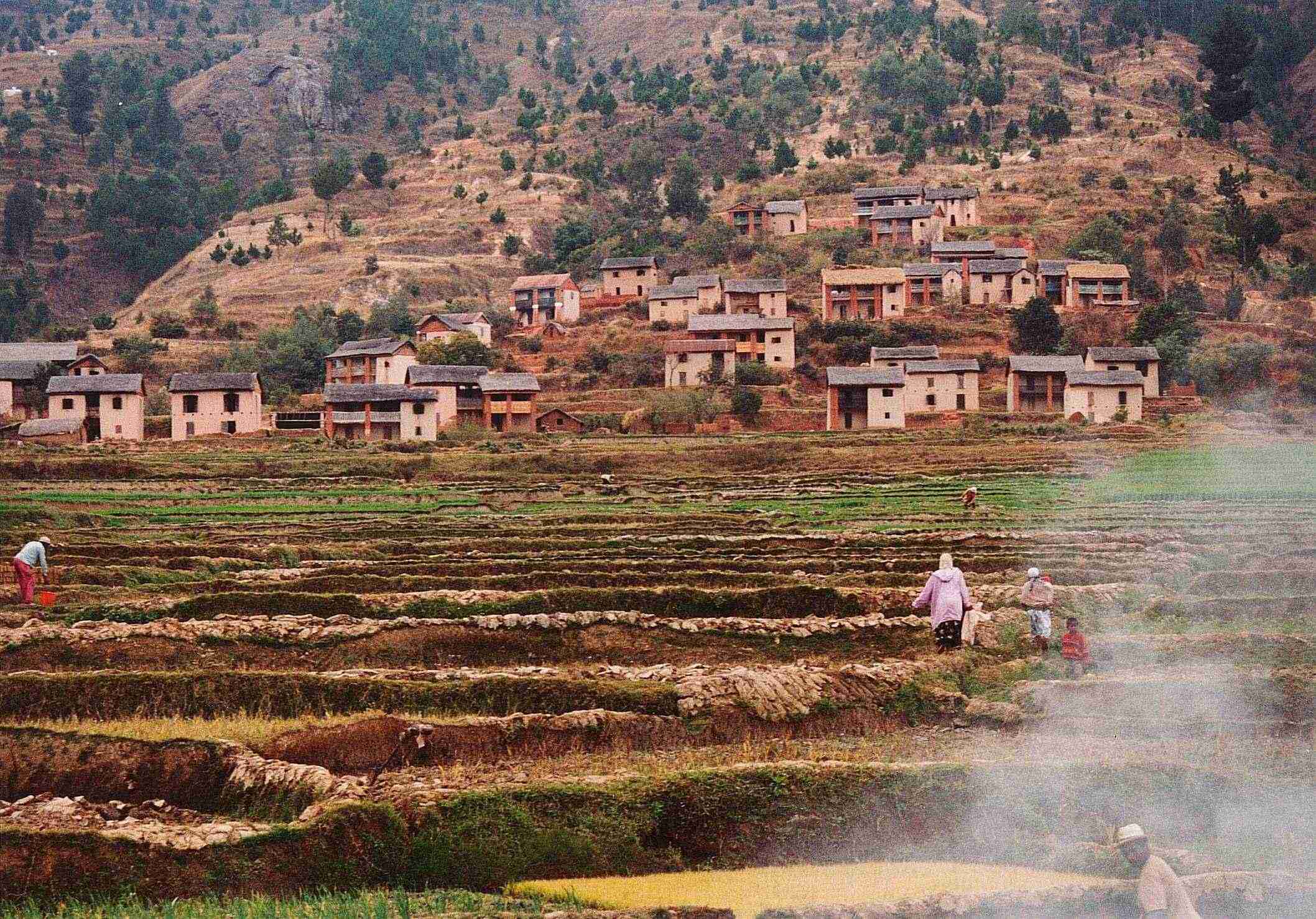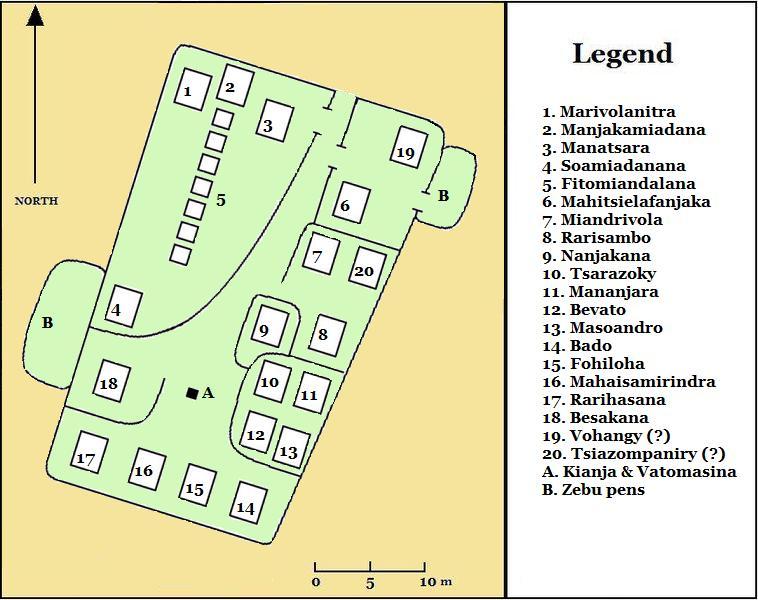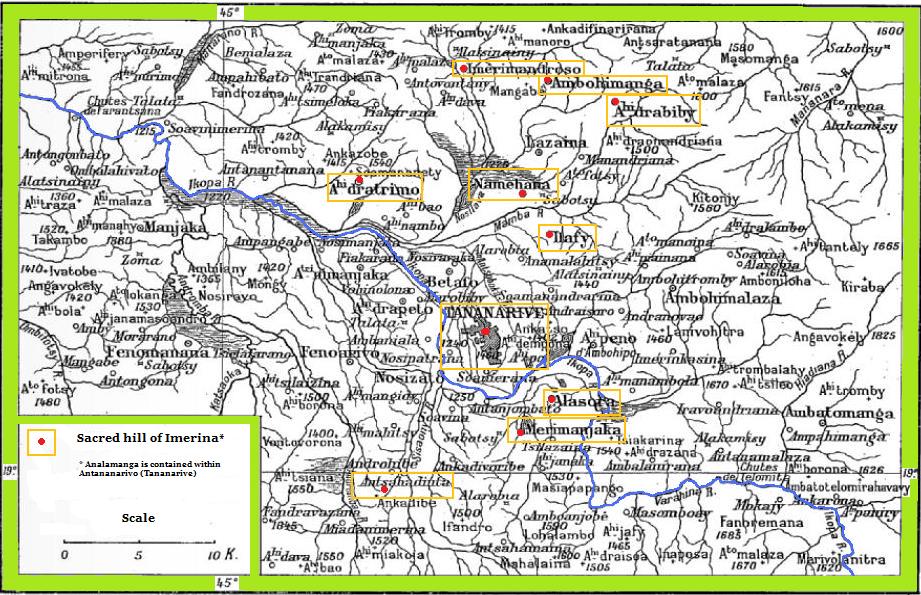|
Andriantsimitoviaminandriandehibe
Andriantsimitoviaminandriandehibe ("the noble without equal among great nobles") was the King of Imerina in the central highlands of Madagascar from 1650 to 1670. He acceded to the throne on the death of his father, King Andriantsitakatrandriana. He had three wives: Ratompoimbahoaka of Ambohimalaza, Princess Ramahafoloarivo (granddaughter of King Andrianjaka), and Princess Rafaravavy Rampanananiamboninitany. He is responsible for establishing the rice paddies of the Betsimitatatra that lie to the west of Ankadimbahoaka.Callet (1908), p. 532 Reign Andriantsimitoviaminandriandehibe pledged to continue his father's work to transform the Bestimitatatra swamps into rice paddies to feed the growing population of Imerina. He selected two of his sons to oversee the labor. The two princes challenged one another to see who could complete their dike fastest. The king proceeded to traditionally divide the territory into northern and southern halves along the Ikopa River and assigned Andrianjaka ... [...More Info...] [...Related Items...] OR: [Wikipedia] [Google] [Baidu] |
Andrianjaka Razakatsitakatrandriana
Andrianjaka Razakatsitakatrandriana or Andrianjakatsitakatrandriana was the King of Imerina in the central Highlands of Madagascar from 1670–1675. He was born in Analamanga as Lamboritakatra, eldest son of King Andriantsimitoviaminandriandehibe. During his father's lifetime, Andrianjakatsitakatrandriana was granted Antananarivo and the land west of it, including Ambohidrabiby, Ambohimanga and regions in the north, as his fief. Although his younger brother, Andrianjakanavalondambo, demonstrated a stronger capacity for wise leadership, Andrianjakatsitakatrandriana was selected to succeed upon the death of their father in 1670. Andriantsimitoviaminandriandehibe took this decision on the basis of the tradition established by their Vazimba ancestors Rafohy and Rangita, who declared that the elder must rule before the younger. In 1675 Andriamampandry and the nobles of Imerina deposed him in favor of his younger brother. Reign Andrianjakatsitakatrandriana married twice during his ... [...More Info...] [...Related Items...] OR: [Wikipedia] [Google] [Baidu] |
Andriantsitakatrandriana
Andriantsitakatrandriana (1613-) was the king of Imerina from 1630 to 1650, acceding to the throne upon the death of his father, Andrianjaka. He took two wives: the first, Ravololontsimitovy, gave birth to his first son and successor Andriantsimitoviaminandriandehibe, while his second wife, Rafoloarivo, gave birth to a son named Andriamanjakatokana. During his reign, he chased his second wife and son from his territory, and constructed dikes to transform the Betsimitatatra swamps around Antananarivo into vast rice paddies to feed the local population. Reign The chief accomplishment of Andriantsitakatrandriana's reign was the initial transformation of the vast Betsimitatatra swamps surrounding the hill of Analamanga into fertile rice paddies through the construction of dikes. Until his time, only ''zozoro'' (an indigenous sedge), rushes, and clusters of trees grew in the marshy lands around the capital city of Antananarivo, which his father had at last wrested from its Vazimba occupa ... [...More Info...] [...Related Items...] OR: [Wikipedia] [Google] [Baidu] |
Andriamasinavalona
Andriamasinavalona (1675–1710), also known as Andrianjakanavalondambo, was a King of Imerina in the central highlands of Madagascar. He made significant and enduring contributions to the social, political and economic life of Imerina. Chief among these was the expansion of his territories and the pacification and unification of certain principalities that had become locked in violent conflict; Andriamasinavalona established and ruled over the largest extent of the Kingdom of Imerina. He gave the name of Antananarivo to the capital city that was rapidly expanding around the royal palace on the hill of Analamanga, created a large public square at Andohalo outside the gates of the city, and named a series of other locations within the city. He also took possession of a distant hill he renamed Ambohimanga as a lodging for his son Andriantsimitoviaminiandriana; the royal city that developed there has been declared a UNESCO World Heritage Site. The innovations of Andriamasinavalo ... [...More Info...] [...Related Items...] OR: [Wikipedia] [Google] [Baidu] |
List Of Imerina Monarchs
This article lists the Imerina monarchs, from the earliest origins of the Merina monarchy until the French conquest of the Merina Kingdom during the Second Madagascar expedition. Early monarchs in the Merina line Below is a list of the line of Merina monarchs that ruled in the Central Highlands of Madagascar and from whom were issued the first true monarchs of a united Madagascar in the 19th century. Before the uniting of Madagascar, succession was based on the current monarch's designation of an heir, typically from among his or her own children. As such, the list below represents a direct genealogical line from the last 19th-century queen of Madagascar to some of the earliest known rulers identified in the 15th century or before. Prior to the 16th century, detailed information about the names and dates of Merina rulers becomes less consistent. Genealogy in this early period are derived primarily from oral history, while later names and dates are verifiable from primary source ... [...More Info...] [...Related Items...] OR: [Wikipedia] [Google] [Baidu] |
Andriamanitrinitany
Andriamanitrinitany was a member of the Merina dynasty of Madagascar in the 17th century. He was the 4th son of King Andriantsimitoviaminandriandehibe of Imerina. King Andriamasinavalona Andriamasinavalona (1675–1710), also known as Andrianjakanavalondambo, was a King of Imerina in the central highlands of Madagascar. He made significant and enduring contributions to the social, political and economic life of Imerina. Chief ... granted him Ambohipoloalina as his fief. He had issue one son (Ratrimomiambonilahy) and two daughters (Princess Ravololondrenitrimo and Princess Ranavolontsimitoviaminandriana-dRalambo I of Anosivavaka). 17th-century African people {{Africa-royal-stub ... [...More Info...] [...Related Items...] OR: [Wikipedia] [Google] [Baidu] |
Rova Of Antananarivo
The Rova of Antananarivo ( mg, Rovan'i Manjakamiadana ) is a royal palace complex (''rova'') in Madagascar that served as the home of the sovereigns of the Kingdom of Imerina in the 17th and 18th centuries, as well as of the rulers of the Kingdom of Madagascar in the 19th century. Its counterpart is the nearby fortified village of Ambohimanga, which served as the spiritual seat of the kingdom in contrast to the political significance of the Rova in the capital. Located in the central highland city of Antananarivo, the Rova occupies the highest point on Analamanga, formerly the highest of Antananarivo's many hills. Merina king Andrianjaka, who ruled Imerina from around 1610 until 1630, is believed to have captured Analamanga from a Vazimba king around 1610 or 1625 and erected the site's first fortified royal structure. Successive Merina kings continued to rule from the site until the fall of the monarchy in 1896, frequently restoring, modifying or adding royal structures within ... [...More Info...] [...Related Items...] OR: [Wikipedia] [Google] [Baidu] |
Ambohimanga
Ambohimanga is a hill and traditional fortified royal settlement (''rova'') in Madagascar, located approximately northeast of the capital city of Antananarivo. It is situated in the commune of Ambohimanga Rova. The hill and the rova that stands on top are considered the most significant symbol of the cultural identity of the Merina people and the most important and best-preserved monument of the precolonial Merina Kingdom. The walled historic village includes residences and burial sites of several key monarchs. The site, one of the twelve sacred hills of Imerina, is associated with strong feelings of national identity and has maintained its spiritual and sacred character both in ritual practice and the popular imagination for at least four hundred years. It remains a place of worship to which pilgrims come from Madagascar and elsewhere. The site has been politically important since the early 18th century, when King Andriamasinavalona (1675–1710) divided the Kingdom of Imeri ... [...More Info...] [...Related Items...] OR: [Wikipedia] [Google] [Baidu] |
1670 Deaths
Year 167 ( CLXVII) was a common year starting on Wednesday (link will display the full calendar) of the Julian calendar. At the time, it was known as the Year of the Consulship of Aurelius and Quadratus (or, less frequently, year 920 '' Ab urbe condita''). The denomination 167 for this year has been used since the early medieval period, when the Anno Domini calendar era became the prevalent method in Europe for naming years. Events By place Roman Empire * Lucius Aurelius Verus Augustus and Marcus Ummidius Quadratus Annianus become Roman Consuls. * The Marcomanni tribe wages war against the Romans at Aquileia. They destroy aqueducts and irrigation conduits. Marcus Aurelius repels the invaders, ending the Pax Romana (Roman Peace) that has kept the Roman Empire free of conflict since the days of Emperor Augustus. * The Vandals (Astingi and Lacringi) and the Sarmatian Iazyges invade Dacia. To counter them, Legio V ''Macedonica'', returning from the Parthian War, moves it ... [...More Info...] [...Related Items...] OR: [Wikipedia] [Google] [Baidu] |
Malagasy Monarchs
Malagasy may refer to: *Someone or something from Madagascar *Malagasy people *Malagasy language *Malagasy Republic *Related to the culture of Madagascar See also *Madagascar (other) Madagascar is an island country located off the eastern coast of Africa. Madagascar may also refer to: Places * Geography of Madagascar * Madagascar Plate Entertainment * ''Madagascar'' (1994 film), a Cuban film by Fernando Pérez * ''Madagas ... {{disambiguation Language and nationality disambiguation pages ... [...More Info...] [...Related Items...] OR: [Wikipedia] [Google] [Baidu] |
Antanamalaza
Antanamalaza is a town and commune in Madagascar. It belongs to the district of Ambatolampy, which is a part of Vakinankaratra Region. The population of the commune was estimated to be approximately 12,000 in 2001 commune census. Primary and junior level secondary education are available in town. The majority 85% of the population of the commune are farmers. The most important crop is rice, while other important products are beans, maize, cassava and potato The potato is a starchy food, a tuber of the plant ''Solanum tuberosum'' and is a root vegetable native to the Americas. The plant is a perennial in the nightshade family Solanaceae. Wild potato species can be found from the southern Unit ...es. Services provide employment for 15% of the population. References and notes Populated places in Vakinankaratra {{Vakinankaratra-geo-stub ... [...More Info...] [...Related Items...] OR: [Wikipedia] [Google] [Baidu] |
Ikopa River
The Ikopa River is the second longest waterway in Madagascar and passes through the capital, Antananarivo. It is the largest tributary of the Betsiboka River. It is formed by the Varahina-North and Varahina-South Rivers. Its spring, named Varahina, is found in the sub-prefecture of Andramasina ''For other localities in Madagascar with the same name, please check: '' Andramasina (other) Andramasina is a town in Analamanga Region, in the Central Highlands of Madagascar Madagascar (; mg, Madagasikara, ), officially th ... at an altitude of 1810 meters. References Rivers of Madagascar Rivers of Analamanga {{Madagascar-river-stub ... [...More Info...] [...Related Items...] OR: [Wikipedia] [Google] [Baidu] |
Twelve Sacred Hills Of Imerina
The twelve sacred hills of Imerina are hills of historical significance to the Merina people of Madagascar. Located throughout Imerina, the central area of the highlands of Madagascar, the sites were often ancient capitals, the birthplaces of key public figures, or the tomb sites of esteemed political or spiritual leaders. The first set of sacred sites was designated by early 17th-century king Andrianjaka. The notion was re-sanctified under late 18th-century king Andrianampoinimerina, who replaced several of the earlier sites with new ones. More than 12 sites were thus designated as sacred over time, although the notion of twelve sacred hills was perpetuated because of the significance of the number 12 in Malagasy cosmology. Today, little concrete evidence of the former importance of many of these sites remains, but the significant archeological and cultural heritage of several of the sites has been preserved. The historic significance of the sites is best represented by the Rova ... [...More Info...] [...Related Items...] OR: [Wikipedia] [Google] [Baidu] |





